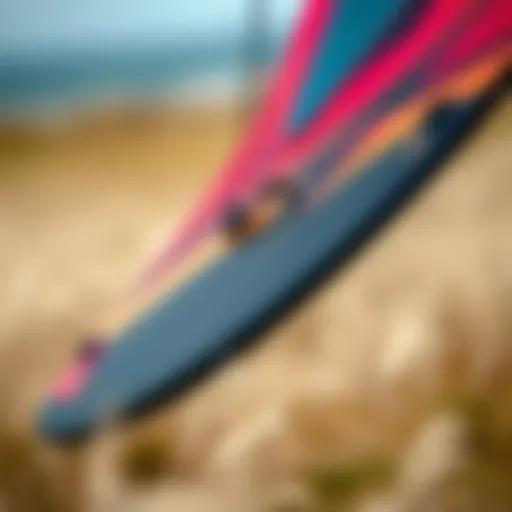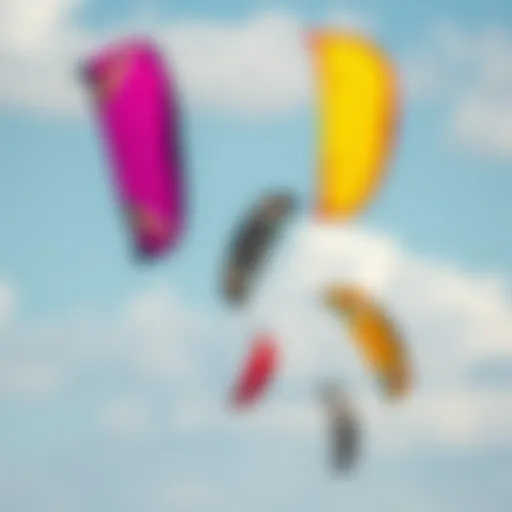The Essential Guide to Board Leashes in Kiteboarding
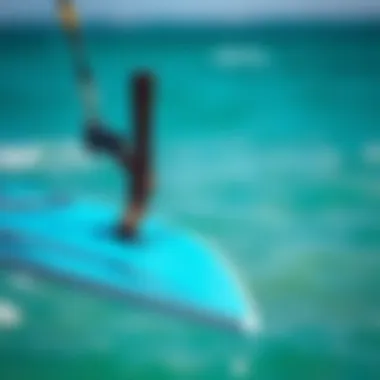

Intro
Kiteboarding is a thrilling sport that blends the elements of wind and water, allowing enthusiasts to glide across the surface with skill and finesse. But amid the exhilaration of carving through waves and catching air, one vital piece of equipment often takes a backseat in discussions: the board leash.
A board leash is not just an add-on; it serves a critical role in enhancing both safety and performance during kiteboarding sessions. Its primary function is to keep the board tethered to the rider, preventing it from drifting away and ensuring that it remains within reach. This is especially important in windy conditions or after falls, where retrieving a board can be not only inconvenient but also hazardous.
As we delve deeper into this guide, we’ll explore the myriad aspects of board leashes, from their types and benefits to necessary maintenance tips. Whether you're a novice or a seasoned pro, understanding the intricacies of board leashes can elevate your kiteboarding experience, ensuring both enjoyment and safety on the water.
Gear and Equipment
In the world of kiteboarding, having the right gear is paramount. While most kiteboarders know about the kite and the board, the importance of the leash is often overshadowed.
Essential Kiteboarding Gear: A Comprehensive Guide
When preparing for a kiteboarding adventure, consider the following essential items:
- Kite: The most significant piece of equipment. Choose based on your skill level and conditions.
- Board: Varied shapes and sizes cater to different riding styles. Consider your preference.
- Harness: This connects the rider to the kite, providing support and control.
- Helmet: Protect your head from potential impacts, especially in challenging conditions.
- Life Jacket: While not mandatory for everyone, they can be crucial for safety in rough waters.
- Board Leash: This is often overlooked but is vital for keeping your board nearby after a tumble.
Focusing on quality when selecting your gear can significantly improve your kiteboarding experience. Ensure each piece of equipment corresponds to your skill level and the environment where you intend to ride.
Maintenance Tips for Kiteboarding Equipment
Proper maintenance of your kiteboarding gear, especially your board and leash, is key to ensuring longevity and performance. Here are some tips to consider:
- Regular Inspection: Check your board leash for wear and tear. Look for frays or weak spots that could compromise its integrity.
- Drying: After each session, rinse your leash with fresh water to remove salt and debris. Hang to dry away from direct sunlight to prevent material degradation.
- Storage: Store your gear in a cool, dry place. Avoid putting heavy items on top of your board and leash to prevent warping and damage.
- Repairing: If you notice any issues, such as fraying or breaking, tackle those early. A simple repair can save you a lot of trouble when on the water.
Those who maintain their equipment not only enjoy a better performance, but also reduce the risk of accidents while out on the water. By treating your board leash and other gear with respect, you'll enhance your overall kiteboarding experience more than you might realize.
"A well-maintained leash is like a steadfast friend on a kiteboard; it always has your back."
In the next sections, we’ll delve into specific techniques and skills tailored to both beginners and advanced kiteboarders, highlighting how to leverage gear like the board leash effectively.
Understanding the Board Leash
In the world of kiteboarding, the board leash is often the unsung hero, yet its role is absolutely essential for safety and performance. Understanding the board leash provides kiteboarders with a foundation to not only enhance their riding experience but also ensure their safety while navigating unpredictable waters. Let's explore the importance of this simple piece of equipment.
Definition and Purpose
A board leash is a cord that attaches a kiteboard to the rider, serving a straightforward purpose: to prevent the board from drifting away in the water after a rider has fallen or has had to dismount. Picture this scenario—you're cruising along, catching some serious air, and then suddenly take a tumble. Without a leash, your board could take off like a runaway train, leaving you scrambling to catch it, and putting your safety at risk if someone else happens to be in the vicinity.
Simply put, the board leash keeps your board within reach, allowing you to maintain control and reduce stray boards that can pose hazards to others on the water. Moreover, if you happen to get separated from your board, losing it could add undue stress to what should be an enjoyable experience.
In a more practical sense, a board leash evolves to match the changing dynamics of sports gear, whether it’s adapting to size, material, or the rigorous demands of differing riding styles. It's not just an accessory; it's a crucial component that connects you to your board, ensuring its swift return allows you to focus on the thrill of riding and mastering new tricks without added distraction.
The Evolution of Board Leashes
Board leashes have come a long way since their inception. Initially simple ropes, they have transformed into specialized gear designed to cater to the evolving needs of kiteboarders.
In the early days of kiteboarding, leashes were often prone to tangling or breaking, which didn't inspire much confidence. However, as kiteboarding gained traction and popularity, manufacturers began to innovate. Now, you’ll find leashes made from durable materials such as polyamide or urethane, engineered to withstand the elements and the rigors of high-speed water sports.
"The board leash has melded with technological advancements, responding dynamically to rider feedback and safety standards."
Furthermore, the design of leashes has seen enhancements in terms of comfort and functionality. Quick-release mechanisms have been introduced to address situations where a rider needs to detach from the board swiftly, such as during a sudden fall or a change in conditions. These modern advancements highlight the change from function-following-form to stylish yet practical designs, which caters to both performance and aesthetic appeal.
As kiteboarding continues to evolve, so too does the board leash. Emerging technologies, including anti-tangle improvements and customizable length options, are just a glimpse of what the future may hold for this crucial piece of equipment.
Understanding the history and purpose of the board leash gives kiteboarders greater appreciation for its function and the necessity of responsibly integrating it into their equipment lineup.
Types of Board Leashes
Understanding the various types of board leashes is essential for kiteboarders looking to enhance their performance while ensuring safety on the water. The right type of leash can make a significant difference in both comfort and functionality, allowing riders to choose what suits their style and the conditions they'll be facing. Below are some of the most common types of board leashes, each bringing its own unique benefits and considerations.
Fixed Board Leash
The fixed board leash is the classic choice among kiteboarders. Designed to securely attach your board to you, it offers consistency and reliability. Generally, this type of leash is favored for its straightforward mechanism, which connects firmly to both the board and the rider's harness.
Key features:
- Durability: Typically made from strong materials, it resists wear and tear over time.
- Simplicity: The ease of attachment allows quick setups before hitting the waves.
Though fixed leashes provide a more direct connection, they also come with a downside: if you fall, the board can remain attached, potentially causing a dangerous situation if the kite pulls unexpectedly. Therefore, a deep understanding of your riding conditions is crucial before opting for this leash type.
Quick Release Board Leash


The quick release board leash takes safety a notch higher by ensuring that riders can detach the board swiftly in case of emergencies. This feature is particularly beneficial in choppy waters or when performing tricks, where losing control can happen in an instant.
Advantages include:
- Safety: Easy release mechanism minimizes the risk of being pulled underwater.
- Versatility: It allows for immediate quick changes during challenging maneuvers and can be reattached very quickly.
Despite these advantages, one must exercise caution. If the quick release fails, it might inadvertently complicate a situation rather than remedy it. Riders should regularly test this mechanism to ensure its reliability.
Wrist Leashes
Wrist leashes, though less common, play an interesting role in kiteboarding. These are primarily used by people who might not want to be tethered directly to their board or those participating in excessive maneuvering. Designed to loop around the wrist, they allow the rider to easily drop the board and swim back if necessary.
Noteworthy points about wrist leashes:
- Freedom of Movement: Riders can detach easily without losing their board, providing a level of freedom.
- Ideal for Beginners: Great for those still mastering techniques, as they reduce the fear of being dragged or overpowered.
However, while wrist leashes are excellent for certain scenarios, they don’t provide the secure feeling that some riders might prefer when navigating larger kiteboarding challenges.
Surfboard Leashes vs. Kiteboard Leashes
One common misconception arises when comparing surfboard leashes and kiteboard leashes. While the two serve a similar purpose, their designs often differ significantly due to the varied nature of the sports.
- Surfboard Leashes: These are typically longer and designed to handle waves and intricate footwork, where the board may need to drift far away without losing it.
- Kiteboard Leashes: Much shorter and more durable to withstand the added tension and pull from the kite. Designed to maintain control even when the kite moves erratically.
Understanding these differences can guide you to make the correct choice based on your preferred style and riding conditions.
In summary, the type of board leash you choose has lasting implications for your kiteboarding experience. Think carefully about the conditions you’ll be riding in and how you plan to use the leash. Making an informed decision can aid safety while amplifying your performance.
Benefits of Using a Board Leash in Kiteboarding
Using a board leash in kiteboarding is not just a matter of convenience; it’s a crucial element that intertwines safety, performance, and the overall kiteboarding experience. When out on the water, the unpredictable nature of waves and winds means that every kiter should consider the implications of losing a board without a reliable attachment. Let’s delve into the multifaceted advantages the board leash brings to the forefront, establishing why it should be an essential accessory for every kiteboarder.
Enhanced Safety on the Water
Safety stands as the top priority for anyone venturing into kiteboarding. Wearing a board leash serves multiple safety functions. First off, should a rider fall, the leash keeps the board close, minimizing the risk of the board drifting away into deeper waters. This is particularly vital in areas where strong currents or waves can quickly carry a board far from the rider.
Moreover, during high winds or turbulent conditions, losing a board can pose a significant hazard, both to the rider and to others nearby. When a person is struggling to paddle back or swim towards their board, they risk not only their own safety but also that of other surfers or kiteboarders. Having that board tethered allows the individual to focus on regaining composure rather than chasing after a disappearing board.
"The board leash is like a lifeline, making sure you're never too far away from your gear in unpredictable conditions."
Improved Board Retrieval
The nature of kiteboarding often puts riders in tricky situations, especially when they wipe out. A board leash tremendously simplifies the process of retrieving a board after a mishap. Instead of having to fight against the wind, waves, and current, a rider can simply pull on the leash to bring the board back into reach. This not only saves time but also energy.
Consider this scenario: you're in choppy waters, and after a gnarly fall, you find your board drifting away. Rather than exhausting yourself by swimming against the tide, the leash provides a manageable way to reel in your board. In the hustle and bustle of kiteboarding, wasting precious energy can be the difference between enjoying the day and calling it quits early.
- The convenience of retrieval allows sailors to:
- Focus on riding instead of chasing.
- Preserve energy for performance or safety maneuvers.
Stability During Tricks
For many kiteboarders, the thrill lies in performing tricks and stunts. When engaged in these maneuvers, the stability that a board leash provides is often underestimated. While doing aerial jumps, spins, or rail grinds, losing a board mid-trick can drastically affect the rider’s performance. Here, the leash acts as a stabilizing force, keeping the board nice and close. This stability ensures the board is exactly where a rider expects it to be, preventing unexpected surprises that could lead to mishaps.
With a secure good-quality leash attached, riders are free to attempt bold moves with added confidence. They can land a trick with the assurance that their board won’t be far behind them, enabling more fluid transitions and smoother rides.
In summary, the benefits of utilizing a board leash in kiteboarding extend way beyond merely keeping track of equipment. They encompass safety considerations, make board retrieval efficient, and add a layer of stability that enhances the overall riding performance. These elements work harmoniously, ensuring riders can enjoy the power of the wind and waves without unnecessary distractions or risks.
Choosing the Right Board Leash
Selecting the appropriate board leash can make a significant difference in your kiteboarding experience. It isn’t merely about grabbing the first one you see; rather, it involves understanding how different leashes cater to unique conditions and your personal riding style. Choosing the right board leash is about safety, convenience, and ensuring you enjoy every moment on the water without unwanted interruptions.
Length Considerations
The length of a board leash affects both control and comfort. A leash that is too short can tether your board too closely, making it difficult to maneuver and possibly leading to more falls. On the flip side, a leash that's excessively long might make the board hard to control, especially in choppy conditions or while executing jumps.
As a general rule, waist-length leashes work for most riders, but understanding your own riding style is key. For instance, if you're focused on tricks, consider a slightly shorter leash. Riders who enjoy leisurely cruising might opt for a longer option. Thus, you need to strike a balance based on these factors:
- Rider height and weight
- Kite size and type
- Water conditions
- Expected maneuvering frequency
Material Quality
Material matters more than you might think. Board leashes are typically constructed from several materials like nylon and polyurethane. Choosing high-quality materials ensures durability and performance over time. If you’re planning to ride in saltwater, ensure your leash has corrosion-resistant components.
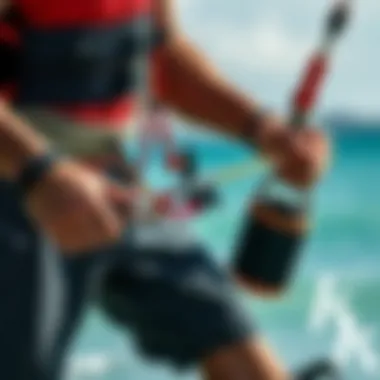

Some qualities to look for include:
- Sturdy Stitches: Well-threaded joints will withstand the tugging that comes with sudden falls.
- Elasticity: Leashes that retain elasticity help absorb shock during losses, reducing the risk of injury.
- UV Resistance: For those long days under the sun, materials resistant to UV will contribute to longevity.
When shopping for a leash, prioritize brands known for their craftsmanship. Less reputable options may save you money upfront but could cost more in the long run.
Attachment Methods
How you attach your leash makes a world of difference. There are several methods to do this, and not all are created equal. One of the most common techniques is the loop system which creates a secure connection between the board and the leash. Other riders might prefer a Velcro strap for quick and easy detachability, especially in tricky situations.
When considering attachment methods, think about:
- Security: Ensures that the leash won’t come off in the heat of action.
- Ease of Use: Some prefer simpler methods that can be managed on the go, while others appreciate the added security of more complex straps.
- Adjustability: A good leash should allow you to tweak how tight or loose it fits, ensuring your comfort throughout your ride.
Integrating these aspects into your decision-making will lead to a better fitting leash that enhances both your performance and enjoyment on the water.
Installation Techniques for Board Leashes
When it comes to kiteboarding, having a proper installation technique for your board leash goes beyond mere practicality. It can spell the difference between enjoying a day on the water and facing unexpected challenges, or worse, dangerous situations. Understanding the various methods to properly attach your leash enhances safety and performance, while preventing costly mishaps. Let’s delve into the essentials.
Connecting to the Board
First things first, connecting your leash to the board must be done securely. Most kiteboards have a designated spot where the leash attaches – often a small loop located near the tail. Before you make that connection, it’s crucial to ensure your board is clean and free of sand or debris. A dirty connection can compromise the reliability of the leash.
- Loop Attachment: Use the loop provided on the leash to connect it to your board. Slide the loop through the attachment point while ensuring there’s no significant slack. A tight connection helps avoid scenarios where the leash could detach during hard maneuvers.
- Testing the Connection: Tug on the leash after attaching it. It should feel secure and not exhibit any give. If it does, reattach it and double-check that everything is snug.
This seemingly simple step can have profound implications for your safety, especially in choppy waters.
Attaching to the Harness
The next step is to connect your leash to your harness. Proper attachment is just as significant, if not more so, than connecting to the board:
- Use the Correct Attachment Point: Most harnesses have a quick-release buckle or a dedicated point for the leash. Ensure you are using the correct point as it allows for quick detachment in emergencies.
- Tension Checks: After attaching, feel the tension in the leash. There should be minimal slack without it being overly tight. An overly tight leash can restrict your movement, while too much slack may lead to entanglements or detachment.
Tip: Periodically check the condition of your harness. If it shows signs of wear, replace it without hesitation.
Avoiding Common Mistakes
Many kiteboarders, especially beginners or those unfamiliar with equipment, can make simple yet avoidable mistakes:
- Incorrect Length: One common error is using a leash that’s either too long or too short. A leash that’s too short can become a hazard during tricks, while an overly long one may lead to tangles, especially in currents.
- Neglecting to Inspect: Failing to routinely check the condition of your leash and connection points can be detrimental. Look for frays, wear, or damaged hooks. If you see any issues, consider replacing components or the entire leash.
- Over-reliance on Leash: While leashes are essential, they shouldn’t be seen as a catch-all safety solution. Proper techniques, like body positioning and board control, are equally vital.
In summary, properly installing your board leash enhances your kiteboarding experience by ensuring your gear functions effectively as part of your setup. Securely attaching it to the board, ensuring proper connection to the harness, and avoiding common mistakes can significantly impact safety on the water. Don't skimp on details; they often make the biggest difference.
Maintenance of Your Board Leash
Maintaining your board leash may seem trivial, but it's a cornerstone of effective kiteboarding safety and performance. Just like checking your kite for tears or ensuring your harness fits snugly, being attentive to your board leash can save you a world of trouble. A well-maintained leash enhances not just your longevity on the water but also your confidence in handling your gear.
Regular Inspections
It's crucial to make a habit of inspecting your board leash regularly. These inspections don't have to be exhaustive; rather, they should be part of your pre-session routine. Look for signs of fraying, tears, or any structural deformities in the attachments. A worn-out leash can spell disaster; if it snaps while you're out in choppy waters, you could find yourself in a sticky situation.
- Check the material – Synthetic materials like nylon or polyester tend to withstand sun and salt, but they break down over time.
- Test the attachments – Ensure that the clasps and connectors function smoothly – a hitch here can cause premature failure.
- Monitor stretch – A leashed that has lost its elasticity is likely past its best days.
"Regular inspections lead to safe kiteboarding. Ignoring your leash? That's like sailing a ship without checking for leaks."
Cleaning Procedures
Keeping your board leash clean is not just about aesthetics; it has a direct impact on the longevity of the material. Saltwater, sand, and freshwater can deteriorate the fibers, weakening your leash significantly. To clean it effectively, simply rinse it with fresh water after each use. Following this step is crucial to remove any tiny particles that may cause abrasions over time.
For a more thorough cleaning, consider the following:
- Use a mild soap solution and a soft brush to scrub away stubborn grime.
- Rinse again thoroughly to remove all soap traces, as any remaining detergent can degrade the leash material.
- Allow your leash to air dry away from direct sunlight to prevent UV-induced weakening.
Signs of Wear and When to Replace
Even with the best care, every board leash has a lifespan. Knowing when to replace your leash is as important as the maintenance rituals to prolong its life. Keep an eye out for these warning signs:
- Frays or cuts – Any significant imperfections can compromise the integrity of the leash.
- Degraded elasticity – If your leash feels limp or doesn’t ‘snap back’ into shape, it’s a sign it’s time for a new one.
- Loss of function – If you find that the connectors do not lock securely anymore or they come apart easily, it's best to err on the side of caution and replace.
Overall, understanding and practicing proper maintenance can vastly improve your kiteboarding experience. Not only does it lead to enhanced safety, but it also boosts your general satisfaction while soaring over the open water. Staying vigilant and committed to caring for your board leash will pay dividends every time you hit the waves, making your sessions smoother and less stressful. For more insights into kiteboarding, you may also check resources like Kiteboarding.com or visit community forums on Reddit.
Integrating Board Leashes in Training
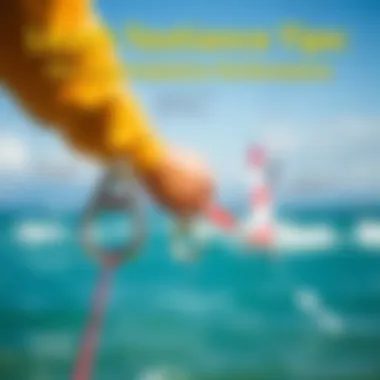

Incorporating board leashes into kiteboarding training sessions can significantly enhance both skill development and safety on the water. A leash is not just an accessory; it serves pivotal functions during practice, helping riders to build confidence as they hone their skills and performance.
Using Leashes for Skill Development
Board leashes are particularly beneficial for beginners, who often grapple with maintaining control over their equipment. Attaching a leash allows novices to focus on learning techniques without the constant worry of losing their board. It aids in reinforcing body positioning, balance, and foot positioning, which are crucial for executing various maneuvers. Likewise, when confidence grows, more advanced riders can experiment with complex tricks while still tethered to their boards. This allows them to push their limits without the fear of a runaway board returning to sender.
Benefits of using a leash in skill development include:
- Reinforcement of Techniques: Riders can practice transitions and jumps without the disruption of chasing after a board.
- Enhanced Flow in Practices: Not having to retrieve the board allows for longer, focused practice sessions.
- Strengthened Safety Net: If a rider falls during a trick or maneuver, a leash prevents the board from drifting away, reducing risks for both the rider and nearby practitioners.
Incorporating Safety Protocols
By integrating board leashes into training, a set of safety protocols can also be established to guide usage. Clear guidelines help both instructors and participants understand the importance of leash use and how to effectively manage it during sessions. Here’s how to ensure safety while training:
- Pre-Training Briefing: Before hitting the water, conduct a briefing that highlights the importance of leashes, focusing on both their benefits and how they should be understood in the context of safety.
- Regular Checks: Instructors should inspect leashes before every training session to ensure they are in good condition — cracks, frays or anything else that signals wear can be a sign to replace them.
- Establishing a Protocol for Attachments: Use consistent methods for connecting leashes to boards and harnesses. This familiarity can prevent mishaps during training.
- Encouraging Caution in Wave Mechanics: Discuss how a leash can actually change how ocean swells and winds affect a board. A rider needs to understand that while it secures the board, it may also add a degree of resistance in emergency situations.
"A board leash isn't just a guideline for keeping your board close; it’s a compass guiding you towards safer practices and skill mastery."
Integrating these protocols into training aids in crafting a culture of safety and responsibility on the water. Continuous dialogue about leash usage ensures participants are mindful of their equipment, enhancing not only their individual safety but that of others in the vicinity as well.
In summary, board leashes are essential in training for kiteboarding, bridging the gap between learning and maintaining safety. By emphasizing proper use, riders of all skill levels can reap the benefits while enjoying their time on the water.
Advanced Techniques in Board Leash Use
Kiteboarding is not just about riding the waves; it’s a delicate dance with the elements. The role of a board leash can’t be overstated, especially when it comes to mastering advanced techniques. Proper utilization of board leashes enhances your riding experience and assists in safety and performance improvements. In this section, we’ll delve into two critical areas: tricks and handling, focusing on the nuances that can set you apart from others on the water.
Trick Riding with a Leash
When it comes to nuancing your kiteboard tricks, having a board leash can be both an asset and a hindrance depending on how you use it. There's a misconception that a leash could tether you down, limiting your potential. But the opposite is often true. When you’re executing advanced tricks, a properly secured board leash ensures that—
- The Board Stays Around: A leash prevents your board from becoming a rogue object during a wipeout, which not only saves it but also keeps others safe.
- Focus on Your Moves: With a board securely attached to your foot, you can concentrate on perfecting your rotations, flips, and more rather than worrying about retrieving your board in chaotic conditions.
- Catching Air: If you lose your board mid-air during a jump, you still benefit from your leash. It allows you to regroup quickly, land, and get right back into your groove without skipping a beat.
However, be aware of potential snags. The tension from the leash can catch your ankle during rotational tricks. Riders often experience a learning curve as they get accustomed to this added element. Mastering the integration between the board leash and your body core is essential.
One must become one with the leash – a silent partner in the aerial ballet that is kiteboarding.
Handling Choppy Waters
Choppy waters can be a real test of mettle for kiteboarders. They present unique challenges that require a finer touch. Using a board leash in these conditions can significantly smooth the ride if properly done.
Points to consider include:
- Stability in Bumpy Conditions: Choppy waters can displace your board unpredictably. The leash stabilizes it, minimizing the likelihood of losing control.
- Quick Recovery: If you wipe out, a board leash ensures your board is close, making it easier to get back on track quickly.
- Maintaining Positioning: When waves are bouncing you around like a pinball, a leash helps maintain your board’s position relative to your body, allowing for faster recovery movements.
However, don’t disregard the impact of wave size and speed on your leash’s function. In really choppy conditions, a too-long leash can increase drag, throwing your balance off. Conversely, a leash that’s too short might create tension that could lead to mishaps. Finding that sweet spot is crucial.
Frequently Asked Questions
When it comes to kiteboarding, board leashes often spark a flurry of questions. This section aims to provide clarity on fundamental concerns that kiteboarders might have regarding their use, safety, and overall impact on the experience on the water. Addressing these FAQs not only serves to enhance one’s understanding but it also underscores the importance of informed decision-making in board leash utilization.
What if don't use a leash?
Choosing not to use a leash while kiteboarding might seem like a personal preference, but there are significant ramifications to consider. Without the tether of a leash, your board can drift away quite rapidly if you wipe out. With the wind at play, boards can travel distances faster than you might think. This situation leads to several challenging scenarios:
- Lost Gear: If your board escapes, retrieving it could turn into a time-consuming affair, potentially disrupting your session and leaving you frustrated.
- Safety Hazards: An unmoored board can become a floating hazard in the water. Other kiteboarders, surfers, or swimmers might inadvertently collide with it, which could lead to dangerous situations.
- Wasted Energy: Without being attached, more physical effort is needed to swim back to your board instead of just pulling it back with the leash.
Hence, opting against a board leash is not just a matter of comfort; it impacts both personal safety and the safety of those around you.
Can a leash become a hazard?
While a board leash is primarily designed to enhance safety, it's not without its pitfalls. Like any piece of equipment, if not used mindfully, a leash could present certain hazards:
- Tangles and Snags: An unsecured leash can easily become tangled around limbs, kite lines, or other surfers. This can create unexpected dangers during a wipeout or in rough waters.
- Overreliance on the Gear: Riders might feel overly confident, thinking the leash guarantees safety. This mindset could lead to riskier stunts or maneuvers, increasing the chances of accidents.
- Improper Attachment: If a leash is not connected appropriately either to the board or the harness, it might snap or detach accidentally, rendering it ineffective when you need it most.
It's crucial to remember the leash is a tool, not a safety net. Proper techniques and vigilance should be balanced with its use to minimize risks.
Understanding the intricacies around board leashes helps kiteboarders approach their sport with a blend of enthusiasm and caution. Making informed choices about whether to use a leash and how to manage it effectively can significantly enhance both performance and safety on the water.
Epilogue: The Role of the Board Leash in Kiteboarding
In the world of kiteboarding, the board leash stands as a silent but essential guardian of both safety and performance. Its seemingly simple role goes beyond just securing the board to the rider; it’s a nuanced instrument that substantially enhances the kiteboarding experience. Adopting the right leash can not only mitigate risks but can also elevate a kiteboarder’s prowess on the waves.
Recap of Key Points
To distill the essence of this guide, let's revisit some key takeaways:
- Definition and Utility: A board leash connects the kiteboard to the rider, ensuring that the board does not drift away in the event of a fall. This minimizes downtime and discourages the loss of gear in open waters.
- Types of Board Leashes: Different leash types like fixed, quick-release, and wrist leashes serve unique purposes. Choosing the correct type is crucial for individual riding styles and safety.
- Benefits of Using a Board Leash:
- Proper Selection and Installation: Knowing the appropriate length, material, and attachment method of a leash can make a significant difference in comfort and functionality. Installation is as important as the leash itself; an incorrectly attached leash can result in problematic scenarios.
- Maintenance: Regular inspections and proper cleaning can extend the life of your leash. Keeping an eye out for wear can save you from unexpected failures on the water.
- Integration in Training: Incorporating leashes into training routines can enhance skill development while reinforcing safety measures.
- Advanced Techniques: Understanding how to use a leash during tricks and in variable water conditions can provide a competitive edge.
- Enhanced Safety: Reduced risk of injury and loss of boards contributes to a safer overall riding experience.
- Improved Retrieval: A securely leashed board makes for quick recovery, which is invaluable in challenging conditions.
- Stability During Tricks: Leashes allow riders to focus more on their moves rather than worrying about losing equipment.
In summary, the board leash in kiteboarding goes much deeper than a mere attachment. It embodies a critical element of safety, convenience, and enhanced performance. For anyone serious about riding the wind and waves, understanding and incorporating the right leash into your gear is not just advisable; it's essential. This guide has aimed at equipping you with the insights necessary to appreciate this indispensable piece of equipment.











